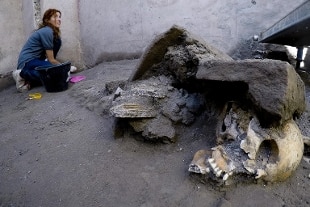Tourism, let's start again: from Pompeii to bed & breakfasts with an app
Bonisoli: "Ferris wheel in Pompeii? We don't talk about it"
Pompeii, English tourist stuck with 3 mosaic tiles from the Domus dell'Ancora in his backpack
Wind sweeps the South, damage to Pompeii.
The wounded woman in Lauria is in serious condition
The "House of Lovers" in Pompeii reopens after 40 years
Pompeii: collapse along the Viale delle Ginestre, checks and interventions are in progress
Share
03 October 2020A new study published by Plos One, an American scientific journal, reveals the discovery of human neurons from a victim of the eruption that in 79 AD buried Herculaneum, Pompeii and the entire Vesuvian area up to 20 km away from the volcano.
The discovery is the result of the work of the forensic anthropologist
Pier Paolo Petrone
, head of the Laboratory of Human Osteobiology and Forensic Anthropology at the Departmental Section of Forensic Medicine of the University of Naples Federico II, in collaboration with geologists, archaeologists, biologists, forensic doctors, neurogeneticists and mathematicians from universities and national research centers.
"The discovery of brain tissue in ancient human remains is an unusual event - explains Petrone - but what is extremely rare is the integral preservation of neuronal structures of a central nervous system of 2000 years ago, in our case to an unprecedented resolution" . The eruption, which caused the devastation of the Vesuvius area and the death of thousands of inhabitants, burying the city of Herculaneum in a few hours, has allowed the conservation of biological remains, including human ones.
"The extraordinary discovery was able to count on the most advanced and innovative electron microscopy techniques of the Science Department of the University of Roma Tre, an Italian excellence where perfectly preserved neuronal structures have been made possible thanks to the conversion of human tissue into glass, which gives clear indications of the rapid cooling of the hot volcanic ash that hit Herculaneum in the early stages of the eruption ", explains Guido Giordano, professor of Volcanology at the Department of Sciences of the Roman University.
"The results of our study show that the unique vitrification process induced by the eruption froze the cellular structures of this victim's central nervous system, preserving them intact to this day," Petrone adds.
The investigations on the victims of the eruption continue in harmony between the various areas of research: "The fusion of the knowledge of the forensic anthropologist and the forensic doctor are giving unique information, otherwise not obtainable", says Massimo Niola, full professor and director of the Uoc of Forensic Medicine at Federico II.
The study also analyzed the data of some proteins already identified by the researchers in a work published last January by the New England Journal of Medicine: "An important aspect could concern the expression of genes that encode proteins isolated from vitrified human brain tissue. ", declares Giuseppe Castaldo, principal investigator of Ceinge and professor of Technical Sciences of Laboratory Medicine of Federico II.
"All the gene transcripts we have identified are present in the various parts of the brain such as, for example, the cerebral cortex, the cerebellum or the hypothalamus", adds Maria Pia Miano, neurogeneticist at the Institute of Genetics and Biophysics of the CNR of Naples .
The investigation into the remains of the victims of the eruption does not stop there. The Archaeological Park of Herculaneum has included bioanthropological and volcanological investigations among its priority research topics due to the interest they may have not only in the narrow scientific field, but also in the field of historical studies and the strengthening of the ability to manage disasters such as eruption of Vesuvius in 79 AD
"The extraordinary results obtained demonstrate the importance of the multidisciplinary studies conducted by the Federico II researchers and the uniqueness of this extraordinary site, once again in the international limelight with its priceless heritage of treasures and archaeological discoveries" , concludes Francesco Sirano, Director of the Archaeological Park of Herculaneum.
The ongoing research goes in the direction of a backward reconstruction of the various phases of the eruption, evaluating the times of exposure to high temperatures and the cooling of flows, which are important not only for archeology and bioanthropology, but also for the volcanic risk. This and other information that will come from the studies in progress will be able to offer important parameters for the management of emergencies in the Vesuvian area.

